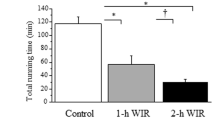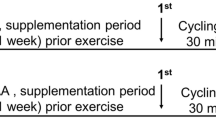Abstract
Phagocytosis and oxidative burst are essential mechanisms of innate immunity by which neutrophils eliminate invading pathogens. Afterwards, phagocytic neutrophils are dissipated by facilitating apoptosis to control inflammation. This study investigates how exercise training with or without hypoxic exposure affects the bactericidal activity and subsequent apoptosis of neutrophils following strenuous exercise. A total of 60 healthy, sedentary men were randomly divided into four groups (n = 15 in each group), who were exposed to 21% O2 [normoxic control (NC)] or 15% O2 [hypoxic control (HC)] at rest or were trained at 50% of peak work rate at 21% O2 [normoxic training (NT)] or 15% O2 [hypoxic training (HT)] for 30 min/day, 5 days/week for 4 weeks. Before the intervention, acute strenuous exercise (SE) enhanced the phagocytosis of Escherichia coli (E. coli) by neutrophils and the release of neutrophil oxidant products in response to E. coli, accompanied by increases in the expression of adhesion molecules (CD62L, CD11b, and CD11a), an opsonic receptor (FcγIIIBR), and complement receptors (C1qRp and CD5aR) on neutrophils. Subsequently, the SE facilitated caspase-3 activation and phosphatidylserine exposure in E. coli-stimulated neutrophils. Furthermore, 4 weeks of HT promoted the expressions of adhesion molecules and opsonic/complement receptors on neutrophils, and it also augmented the bactericidal and apoptotic activities of neutrophils at rest or after SE. However, NT, HC, and NC did not influence these neutrophil-related immune responses to strenuous exercise. Therefore, we conclude that the HT regimen effectively promotes the bactericidal capacity of neutrophils, and facilitates their subsequent apoptosis both at rest and following SE.





Similar content being viewed by others
Abbreviations
- AMS:
-
Acute mountain sickness
- BP:
-
Blood pressure
- C1qR:
-
C1q receptor
- C5aR:
-
C5a receptor
- VCO2 :
-
CO2 production
- CR1:
-
Complement receptor 1
- DHR-123:
-
Dihydrorhodamine-123
- PETCO2 :
-
End-tidal carbon dioxide tension
- PETO2 :
-
End-tidal oxygen tension
- E. coli:
-
Escherichia coli
- FcγIIIBR:
-
Fcγ receptor-type IIIB
- FITC:
-
Fluorescein isothiocyanate
- GXT:
-
Graded exercise test
- HBSS:
-
Hank’s balanced salt solution
- HR:
-
Heart rate
- HIF-1:
-
Hypoxia-inducible factor-1
- HC:
-
Hypoxic control
- HT:
-
Hypoxic exercise training
- LFA-1:
-
Lymphocyte function-associated antigen-1
- Mac-1:
-
Macrophage-1 antigen
- VE :
-
Minute ventilation
- NADPH:
-
Nicotinamide adenine dinucleotide phosphate
- NC:
-
Normoxic control
- NT:
-
Normoxic exercise training
- VO2 :
-
O2 consumption
- PS:
-
Phosphatidylserine
- ROS:
-
Reactive oxygen species
- SaO2 :
-
Oxygen saturation
- SE:
-
Strenuous exercise
References
American College of Sports Medicine (2014) Clinical exercise testing. ACSM’s guidelines for exercise testing and prescription, 9th edn. Lippincott Williams & Wilkins, Philadelphia, pp 114–141
Arnaout MA (2008) Phagocytosis and comparative innate immunity: learning on the fly. Nat Rev Immunol 8:131–141
Bocqueraz O, Koulmann N, Guigas B, Jimenez C, Melin B (2004) Fluid-regulatory hormone responses during cycling exercise in acute hypobaric hypoxia. Med Sci Sports Exerc 3:1730–1736
Cross AR, Segal AW (2004) The NADPH oxidase of professional phagocytes–prototype of the NOX electron transport chain systems. Biochim Biophys Acta 1657:1–22
Diacovo TG, Roth SJ, Buccola JM, Bainton DF, Springer TA (1996) Neutrophil rolling, arrest, and transmigration across activated, surface-adherent platelets via sequential action of P-selectin and the beta 2-integrin CD11b/CD18. Blood 88:146–157
Greenlee-Wacker MC (2016) Clearance of apoptotic neutrophils and resolution of inflammation. Immunol Rev 273:357–370
Kong T, Eltzschig HK, Karhausen J, Colgan SP, Shelley CS (2004) Leukocyte adhesion during hypoxia is mediated by HIF-1-dependent induction of β2-integrin gene expression. Proc Natl Acad Sci 101:10440–10445
Lee WL, Harrison RE, Grinstein S (2003) Phagocytosis by neutrophils. Microbes Infect 5:1299–1306
Lewis MJ, Botto M (2006) Complement deficiencies in humans and animals: links to autoimmunity. Autoimmunity 39:367–378
Malech HL, Hickstein DD (2007) Genetics, and biology and clinical management of myeloid cell primary immune deficiencies: chronic granulomatous disease and leukocyte adhesion deficiency. Curr Opin Hematol 14:29–36
Malhotra R, Tyson DW, Rosevear HM, Brosius FC 3rd (2008) Hypoxia inducible factor-1alpha is a critical mediator of hypoxia induced apoptosis in cardiac H9c2 and kidney epithelial HK-2 cells. BMC Cardiovasc Disord 8:9
Montero D, Lundby C (2016) Effects of exercise training in hypoxia versus normoxia on vascular health. Sports Med 46:1725–1736
Nauseef WM (2007) How human neutrophils kill and degrade microbes: an integrated view. Immunol Rev 219:88–102
Neubauer JA (2001) Invited review: physiological and pathophysiological responses to intermittent hypoxia. J Appl Physiol 90:1593–1599
Perskvist N, Long M, Stendahl O, Zheng L (2002) Mycobacterium tuberculosis promotes apoptosis in human neutrophils by activating caspase-3 and altering expression of Bax/Bcl-xL via an oxygen-dependent pathway. J Immunol 168:6358–6365
Powell FL (2006) Lake Louise consensus methods for measuring the hypoxic ventilatory response. Adv Exp Med Biol 588:271–276
Schroedl C, McClintock DS, Budinger GR, Chandel NS (2002) Hypoxic but not anoxic stabilization of HIF-1 requires mitochondrial reactive oxygen species. Am J Physiol Lung Cell Mol Physiol 283:L922–L993
Serhan CN, Savill J (2005) Resolution of inflammation: the beginning programs the end. Nat Immunol 6:1191–1197
Sim S, Yong TS, Park SJ, Im KI, Kong Y, Ryu JS, Min DY, Shin MH (2005) NADPH oxidase-derived reactive oxygen species-mediated activation of ERK1/2 is required for apoptosis of human neutrophils induced by Entamoeba histolytica. J Immunol 174:4279–4288
Stuart LM, Ezekowitz RA, Zinkernagel AS, Johnson RS, Nizet V (2007) Hypoxia inducible factor (HIF) function in innate immunity and infection. J Mol Med 85:1339–1346
Tuttle SW, Maity A, Oprysko PR, Kachur AV, Ayene IS, Biaglow JE, Koch CJ (2007) Detection of reactive oxygen species via endogenous oxidative pentose phosphate cycle activity in response to oxygen concentration: implications for the mechanism of HIF-1 stabilization under moderate hypoxia. J Biol Chem 282:36790–36796
Wang JS, Chiu YT (2009) Systemic hypoxia enhances exercise-mediated bactericidal and subsequent apoptotic responses in human neutrophils. J Appl Physiol 107:1213–1222
Wang JS, Liu HC (2009) Systemic hypoxia enhances bactericidal activities of human polymorphonuclear leuocytes. Clin Sci 116:805–817
Wang JS, Jen CJ, Lee H, Chen HI (1997) Effects of short-term exercise on female platelet function during different phases of the menstrual cycle. Arterioscler Thromb Vasc Biol 17:1682–1686
Wang JS, Wu MH, Mao TY, Fu TC, Hsu CC (2010) Effects of normoxic and hypoxic exercise regimens on cardiac, muscular, and cerebral hemodynamics suppressed by severe hypoxia in humans. J Appl Physiol 109:219–229
Wood JG, Johnson JS, Mattioli LF, Gonzalez NC (2002) Systemic hypoxia increases leukocyte emigration and vascular permeability in conscious rats. J Appl Physiol 89:1561–1568
Zhang B, Hirahashi J, Cullere X, Mayadas TN (2003) Elucidation of molecular events leading to neutrophil apoptosis following phagocytosis: crosstalk between caspase 8, reactive oxygen species, and MAPK/ERK activation. J Biol Chem 278:28443–28454
Acknowledgements
The authors would like to thank the volunteers for their enthusiastic participation in the present study.
Funding
This work was supported by the National Science Council of Taiwan (Grant number NSC 105-2314-B-182-013-MY3), Chang Gung Medical Research Program (Grant number CMRPD3G0031), and the Healthy Aging Research Center, Chang Gung University (Grant number EMRPD1A0841).
Author information
Authors and Affiliations
Contributions
JSW was involved in conception and design of research; YCC and WYC performed experiments; YCC, WYC, and JSW analyzed data, interpreted results of experiments, prepared the Figures, and drafted the paper; JSW, YCC, and TCF edited and revised the paper; JSW, YCC, WYC, and TCF approved the final version of paper.
Corresponding author
Ethics declarations
Conflict of interest
No conflicts of interest, financial, or otherwise, are declared by the authors.
Additional information
Communicated by Fabio Fischetti.
Rights and permissions
About this article
Cite this article
Chen, YC., Chou, WY., Fu, TC. et al. Effects of normoxic and hypoxic exercise training on the bactericidal capacity and subsequent apoptosis of neutrophils in sedentary men. Eur J Appl Physiol 118, 1985–1995 (2018). https://doi.org/10.1007/s00421-018-3935-7
Received:
Accepted:
Published:
Issue Date:
DOI: https://doi.org/10.1007/s00421-018-3935-7




